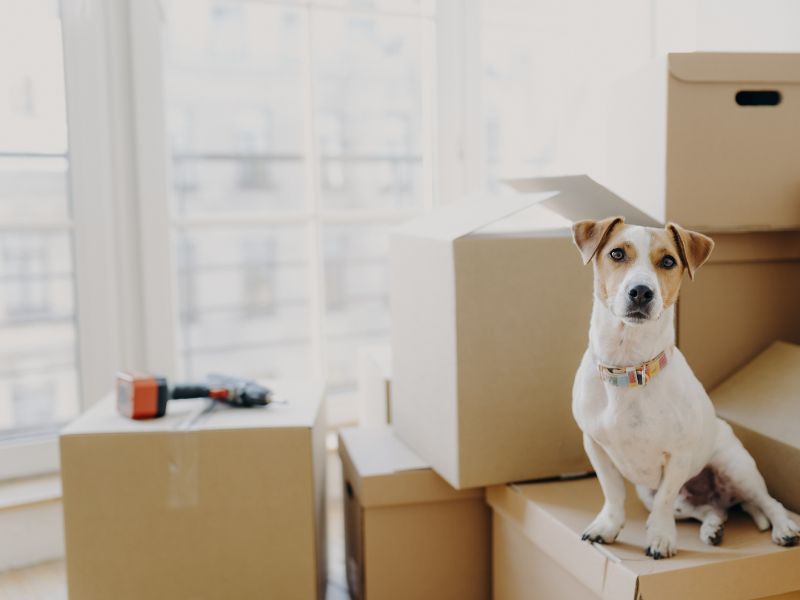FOLLOW
@AMITMANHASREALESTATE
My blog is written with you in mind; to help answer your questions and share professional insights so you can reach your real estate goals with ease.
I'm Amit
MARKET REPORT
SELLING
BUYING
Moving to a new home is a big event for everyone involved, including your pet. While your pet doesn’t have to do any of the packing, it can still be stressful and exhausting. Both cats and dogs develop strong bonds with their homes. It’s their safe zone. Some pets can therefore experience some anxiety and stress as they struggle to adjust to their new environment.
Moving with pets requires careful planning, as well as patience, but it can be done with some care and attention. Afterall, pets are part of the family, and it’s important they’re included in the move. Follow these easy tips to help prepare your pet for the move and transition successfully into their new home.
TALK ABOUT THE NEW HOME
Your pet knows what’s up and can sense when there’s something out of the ordinary going on. Talk to your pet and let them know what’s going on. Start as early as preparing your house for the market and show your home to strangers. By the time you start packing boxes and moving furniture, talk out loud about all the fun possibilities to be had in your new home. Does it have a bigger yard? Is there a big window for sunbathing and squirrel watching? Your pet will pick up on your positive vibe and will feel reassured about the changes happening around them.
UPDATE YOUR PET’S INFORMATION
Before the move, inform your vet that you will be moving so that you can get any necessary prescriptions filled ahead of time. This will also allow them to update your information or transfer documents to a new vet if you are moving to a new area. This includes updating, or getting a microchip. A microchip is a small device inserted under the skin, usually in the scruff of the neck. It contains information, such as your address and phone number, that can be used to identify your pet if they do go missing. But that microchip is only as good as the information associated with it. So be sure to add ‘updating pet microchip’ to your moving checklist.
Here’s some helpful contact information for common microchip companies in Canada:
phone: 1-888-346-8899
fax: 1-866-467-5160
email: info@eidap.com
phone: 1-800-338-1397
Microchip 4 Solutions Inc. (M4S ID) website
phone: 1-877-738-4384
CLEAN THE NEW HOME
Before you introduce your pet to the new house, give it a thorough clean. Top to bottom. Wall to wall. Have carpets and drapes professionally cleaned if you can. This is especially important if there were previous pets around. Eradicating old, unfamiliar scents will help create a neutral setting, one where your pet will be able to easily establish the new home as their territory.
CREATE A SAFE SPACE FOR YOUR PET
Set up a safe, quiet space for your pet to relax. Pets, especially dogs, rely heavily on scents. In a new home, there will be a lot of new scents that can overwhelm them. You can help them settle by bringing things that smell like home, like their favourite toys and bedding, which are covered in the scents they are used to as soon as you move in. Be sure to show your pet this area, and spend time with them here so when they feel overwhelmed or insecure, they know they can escape to their safe place.
KEEP YOUR ROUTINE CONSISTENT
Pets do best when they have a routine. There’s nothing more comforting for a pet than knowing what to expect and when. Unfortunately, moving can disrupt that. Although your life will be hectic during the move, try your best to keep your pet’s routine consistent. Keeping the same meal and walk times will really help keep your pet’s stress level down. Try to keep up with the routine they’re used to as closely as possible. This will help them adjust faster because while their environment has changed, their life with you hasn’t.
EXPLORE YOUR NEW HOME TOGETHER
Walk around and explore your new home with your pet, allowing them to sniff around and check things out as you go. Leave treats around the house to create a positive association. Do this a few times, if possible, to help your pet establish this new area as safe and familiar. Keep them on a lead for the first few days so they can learn where the boundaries are in and around the house, driveway, and street.
It’s important to give your pet time to get used to their new home before leaving them alone. But if you keep them closed off for too long, it will increase their anxiety. As soon as it’s safe to do so, let them start exploring the new place on their own so they can get used to everything in their own way.
GIVE THEM EXTRA ATTENTION
For a pet that is particularly anxious, give them a lot of extra attention for the first few weeks in the new place. Affection helps your pet to calm down and will help them trust that everything is okay and back to normal.
Moving with pets seems easy enough in principle. The challenge is keeping them front and center as you yourself are transitioning to a new home too. But when executed, you are making sure your pet moves to their new home stress and care-free. The key is to go slow and steady with the transition. Treats help!
Leave a Reply Cancel reply
This site uses Akismet to reduce spam. Learn how your comment data is processed.
From negotiations to paperwork, buying a home can get overwhelming fast. Want some inside knowledge?
The Ultimate Home Buyers Guide
free download
Site Credit
© 2025 Amit Manhas | All Rights Reserved | Terms of Use |

Leave a comment